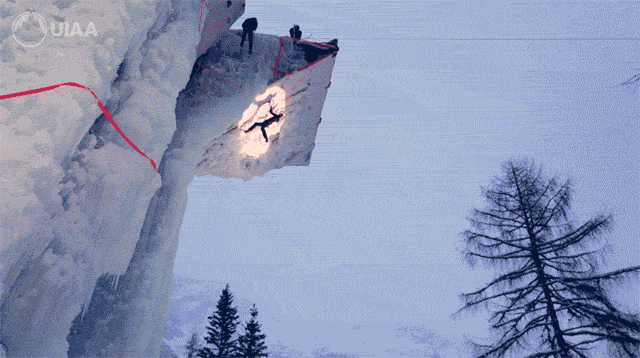The design and fabrication of artificial ice-climbing structures is an incredibly creative yet widely overlooked form of experimental architecture. The resulting constructions are often astonishing: ice-covered loops, ledges, branches and towers reminiscent of the playful 1960s experiments of Archigram, yet serving as some of the most spatially interesting athletic venues in all of today’s professional sports.
After a brief conversation with some friends about the fact that ice-climbing had been included in this year’s Olympic Games in Sochi — albeit as a “cultural demonstration,” not as an officially recognised athletic event — I took a quick look back at some of the existing facilities for ice-climbing competitions around the world. While this won’t be news to many of you, the structures are well worth a view.

Photo by Łukasz Warzecha, courtesy of UIAA
Huge rings and pillars stand over the landscape, progressing upward and outward through increasingly ambitious cantilevers and rings, like an artificial frozen waterfall or perhaps the ruins of some fairy-tale castle locked in long draperies of ice.
Wooden cubes and logs studded with hand-holds dangle from ropes, swaying in the wind (and with every gentle movement of the climber). It is architecture trying to shake humans free.
As Rock and Ice describes it, “Creative coursesetters long ago shucked the idea of simulating nature, and now launch the adept climbers up artificial walls to wrench and jump around on hanging cylinders and geometric figures as well as icicles.”

However, if it all looks rather graceful, you immediately see that this is, in fact, a competition, as climbers armed with ice axes all but sprint up the vertical surfaces, chipping into ice and wood alike, pulling themselves up — and over, and around — the various obstacles.

The GIFs seen here were made from videos of competitions that took place in Saas Fee, Switzerland, and Rabenstein, Italy, as well as a youth climbing competition in Champigny, France.
Even more awesomely, in Saas Fee’s case, the climbing took place inside a large, multi-story parking garage that is converted into an ice-climbing venue every year.
The UIAA Ice Climbing World Cup, for which these venues were constructed, has been going on annually since 2002.
In any case, I’ve been focusing on the architecture here because I find it totally fascinating that niche sports enthusiasts seem to have discovered — and, perhaps more importantly, their activities also financially support — a unique type of architectural structure, one that would appear quite eccentric, even fairly avant-garde, if seen in an everyday urban context.
Imagine an unnamed city somewhere, its streets lined with what look like fragments of some vast artificial glacier, frozen super-crystals looming over plazas and parks, as modular cliffs and ice towers sparkle in the twilight. People move amidst these engineered forms, a false winter maintained by technicians working away in high-tech booths beneath the city, controlling these ice fields for everyday citizens to climb.
It sounds like something out of a science fiction film — even a book by Dr. Seuss — yet, here, in a radically scaled-down version, we can take it all for granted as simply a professional sports venue, shrugging our shoulders at an athletic event held annually. But some times the most magical examples of architecture are hidden in plain view, as the world of recreational sports continues, somewhat unexpectedly, to pioneer brand new spatial environments.
In other words, let’s get more architects and athletes together so that we can all dream of — and actually build — new, mind-blowing future structures for human exploration and activity, treating the spatial needs of emerging sports as a resource for architectural thinking.
A few sentences in the final four paragraphs are heavily rewritten from an earlier post on BLDGBLOG.
